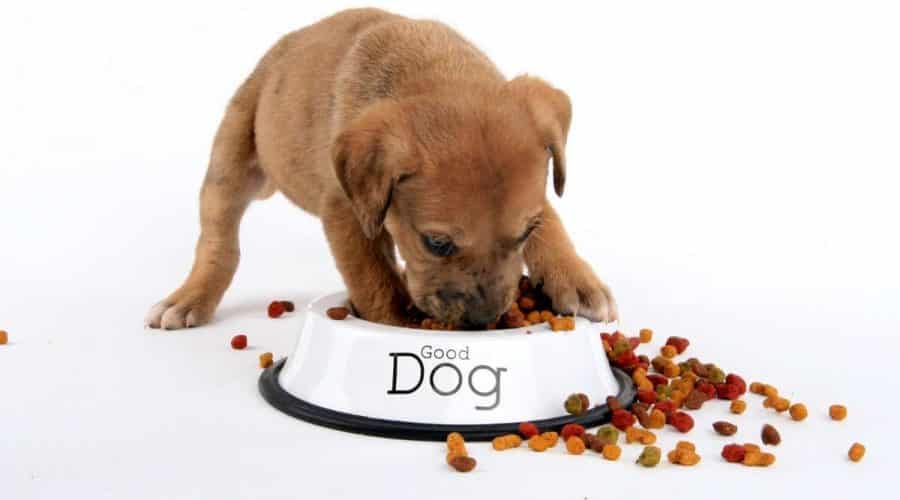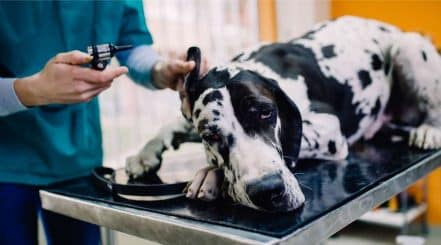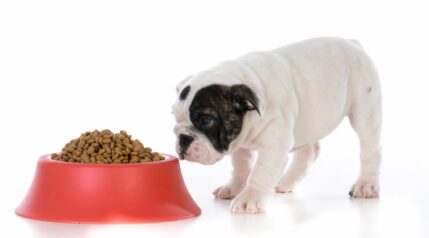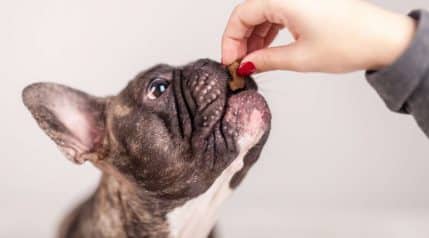The Great Dane is a giant breed full of love. They are affectionate, fun, and enjoy being part of a family. Great Danes are known as “gentle giants” because they are both huge and calm. They are the tallest dog breed in the canine world. Since they are such big dogs, monitoring their nutritional intake, especially during puppyhood, is essential to see if they are growing up healthily.
Puppy nutrition can be a little tricky. You probably have a few questions regarding how to feed your new pup properly. Puppy parents often want to know how much they should feed their puppy, should the amounts change as they grow, and what kinds of food they should feed their new companion?
Our comprehensive guide gives you a look into your Great Dane’s nutritional requirements throughout their early years. We’ve also provided a nutritional chart as a handy resource to refer back to as your puppy grows. Finally, we answer the most frequently asked questions about your dog’s nutrition as they develop.
Great Dane Puppy Feeding Chart At A Glance
| Age | Type of Food | Cups a Day | Meals a Day |
|---|---|---|---|
| 0 – 30 days | Mother’s Milk | n/a | Unlimited |
| 4 – 6 weeks | Kibble & Water | 3/4 food, 1/4 water | Unlimited |
| 8– 11 weeks | Puppy Kibble | 2-3 | 3 – 4 |
| 12 weeks – 6 months | Puppy Kibble | 5 | 2 – 3 |
How Much Should A Great Dane Puppy Eat?
Although all dogs are different, here are some general rules of how much a Great Dane puppy should be eating. If you are curious about more details regarding your dog’s growth milestones, you can consult our Great Dane growth chart.
Week 1
Although most pet owners will not receive a puppy when it is one week old, there may be some situations where you will have to care for a pup this young, so we’ve included the first few weeks for reference.
The first week is crucial for a puppy’s development. During this week, he will primarily drink his mother’s milk which is full of nutrients. Mother’s milk is full of colostrum, which provides the pups with the infection and germ-fighting protection their immune system needs. Receiving these antibodies in the first few days is essential for your pup’s health. Let the puppies nurse for long as they like and need. If the mother is not producing enough milk, please get in touch with your vet immediately.
Week 2
At two weeks old, the little pup will still be feeding on his mother’s milk. By this point, the more feisty and aggressive pups will feed more while the smaller, more docile ones may stay behind. Try to get the slighter puppies to feed first if you notice this happening consistently. You can even supplement their feedings with puppy formula. Check with your vet for a brand that will work well with Great Danes.
Week 3
Curious Great Dane puppies will start exploring and moving more at three weeks. They should continue nursing but can be introduced slowly to moistened kibble. However, the mother’s milk should be the primary food they eat.
Week 4
This week, Great Dane puppies can slowly be introduced to soften kibble, although their diet will still be predominantly milk. Mix a small handful of fresh food or kibble with water – the mixture should be 1/4 food and 3/4 water. They may not take to the food immediately. This is okay. Give them time to adjust, and do not force-feed them.
Great Danes are considered a giant breed, and their food should be designed to support their growth and nutritional needs. When selecting a kibble, ensure that the food is created for “giant breeds.”
Week 5
By week 5, Great Dane puppies may be more inclined to eat kibble. They will most likely still be nursing, but they are slowly becoming more independent.
Week 6
Great Dane puppies should be more interested in eating the kibble mixture at six weeks than their mother’s milk. They may still try to nurse with mom. This is normal. Six weeks is a marker to assess if your pup is doing well on the moistened kibble without any adverse effects. It’s time to wean him off milk. You should gradually change the kibble throughout the week until it becomes 3/4 food and 1/4 water.
Week 7
Great Dane puppies should be almost entirely weaned at seven weeks, if not wholly. Some may try to nurse from mom, but she may not allow them at this point. The kibble mixture should be working well for them.
Week 8
Eight-week-old Great Dane puppies should be fully weaned and solely eating dog food. A typical Great Dane eight-week-old pup consumes around two to three cups of food a day, divided into two or three meals. This is usually when most puppies are sent off to their new homes.
Breeders or adoption shelters usually give new owners enough food to gradually switch the puppy to the new brand you will be feeding them. If this is not the case, you will have to ask the breeder what kind of food they used and buy a small bag for yourself. Be sure to switch them over gradually. Changing their food too fast can cause stomach upset. Typically, dog food transitioning takes between 10 and 14 days. If you’re going to use the same food, there is no need for a transition phase.
Week 9
At nine weeks, Great Danes will continue to eat two to three cups of kibble in two to three meals.
As you and your puppy get acclimated to your new lives, it is vital to establish a feeding routine. Do not leave food out the entire day. After feeding, wait an hour or two before taking the pup for a walk. Great Danes are known to suffer from bloat, which can be deadly. You should not exercise them immediately after eating.
Week 10
By now, you’ve probably visited your vet for his first check-up. Your vet will tell you whether your pup is lacking behind, at a healthy weight, or becoming too chunky. At ten weeks, Great Danes will continue to eat two to three cups of kibble in two to three meals. Whatever your vet’s observations, be sure to follow any new instructions.
Week 11
Great Danes will continue to eat two to three cups of kibble in two to three meals at eleven weeks. After a few weeks of exploring and adapting to his new surroundings, your pup should show his appetite more than ever before. However, it’s essential to stick to your set routine. If your puppy leaves his food, take it away after 10 minutes. He’ll soon learn to eat when fed instead of expecting food every few hours.
Week 12
Your puppy can slowly start eating two meals a day on week twelve. His food intake will increase to three to five cups a day. Monitor his appetite to see if he is ready to spread his meals out twice daily.
Week 13
Your puppy will continue to eat three to five cups a day at thirteen weeks. He is most likely playing more and growing fast! He will need more food to sustain his energy and promote his growth.
Week 14
Your Great Dane puppy is starting to show his size by fourteen weeks. He will begin to grow bigger and bigger and need all the nutrients to support his development. He will continue to eat three to five cups a day, but the amount will increase from here on out.
Different Types Of Puppy Food

- Fresh (human-grade)
- Kibble (dry food)
- Canned or pouch (wet food)
- Raw or BARF (biologically appropriate raw food)
- Home-cooked food
High-quality dog food like human-grade is food that is legally suited for human consumption. This food undergoes quality-control checks to ensure cleanliness and high-grade meat selection.
Kibble
Kibble, or dried dog food, comes in different-sized bags. This is very useful in selecting a brand that your puppy will enjoy. You can purchase a small bag as a test run. If he likes it, then you can go ahead and get the larger bag.
Great Danes can be prone to Gastric Dilation Volvulus (GDV), also known as bloat. Research has shown that feeding them bigger-sized kibble can help reduce the onset of GDV. Kibble pieces bigger than 30mm in size are recommended.
The majority of brands will offer a kibble specifically designed to meet the nutrient requirements of giant breed puppies. Make sure you choose a brand that includes essential fatty acids and high percentages of protein. Grain-free is also recommended.
Canned or processed foods are often higher in fats, which is not ideal for puppies who need to grow steadily.
A raw diet or Biologically Appropriate Raw Food (BARF) can be too rich for puppy stomachs and could irritate their bellies. Choose a brand that meets a Great Dane’s nutritional requirements.
You can buy BARF meals in frozen packs. These can be defrosted when you need them. The majority of dogs love raw food. Be careful handling raw food as it can have a higher risk of contamination.
The Importance Of High-Quality Food
Great Danes have three life stages; puppyhood, adulthood, and senior years. Puppyhood is the most critical nutritional life stage because it sets the foundations for healthy habits and the framework for a healthy body. Substandard food contains fillers, artificial parts, preservatives, colors, and chemicals. It has little to no nutritional value. Poor quality food can put your pup at risk of becoming nutritionally deficient or not developing correctly.

Best For Puppies
Purina Pro Puppy Formula Large Breed

Best For Adults
The Farmer’s Dog
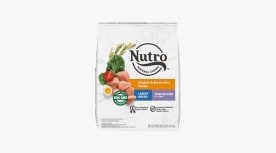
Best For Seniors
Nutro Natural Choice Large Breed Senior
Note: Clicking the above links take you to Amazon.com or each company’s website, where you can get additional product information and customer reviews. If you make a purchase, we earn a commission at no extra cost to you.
Why Is Giant Breed Puppy Food Important?
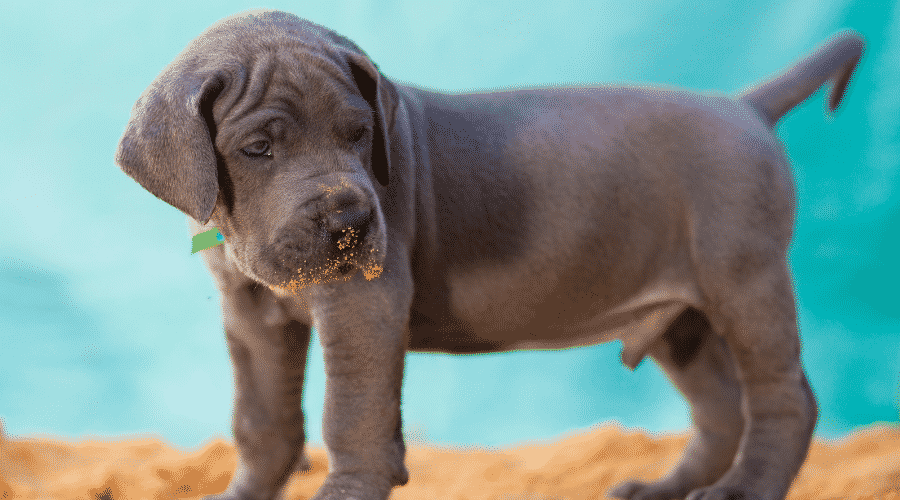
Your Great Dane is considered a giant breed. Therefore, you should feed him specialized food for giant breeds. The nutrition inside each piece is calibrated and optimized for specific nutrients like calcium, phosphorus, fats, protein, and vitamin D. Sometimes brands that claim to be suitable for all-sized breeds are unsuitable for giant dogs. Their food must contain the right vitamins and nutrients to thrive.
What Nutrients Do Great Dane Puppies Need?
Protein
Dogs require animal protein to survive and grow. It is an essential nutritional component in their diet. Animal protein helps your dog’s skin, muscles, and joints develop. Your dog also benefits from plant protein. Starchy vegetables like peas, chickpeas, and lentils have high amounts of natural protein.
The first ingredient in puppy food should always be animal protein. The protein content in puppy food for your Great Dane should be between 23% and 24%.
Carbohydrates
Protein alone is not sufficient to keep your pup fueled for the day. They also need carbs in their diet. Healthy carbs can be found in grains, such as rice, barley, and oatmeal. They can also be found in veggies such as peas, sweet potatoes, and lentils. Great Danes can also eat bits of berries, applesauce, and melon.
Fiber
Fiber is a complex carbohydrate that is essential for your puppy’s diet. Fiber helps regulate the digestive system, reduce dental plaque and tartar, balance blood cholesterol levels, control body weight, and manage chronic large bowel diarrhea and constipation. Fiber is also a low-calorie food that keeps your puppy feeling fuller for longer. Look for fiber-rich ingredients such as sweet potatoes, spinach, beet pulp, and chicory root.
Omega Fatty Acids
Fatty acids are crucial for healthy puppy development. They help his brain and eyes develop healthily, keep his skin and coat nourished, assist with vitamin absorption, and boost overall wellness. Their fat intake should be 12%. Look for ingredients such as meat meals, fish, fish oils, flaxseed, and canola oils.
Vitamins And Minerals
Great Danes have health concerns that could emerge due to increased vitamins or minerals. Vitamins and minerals are needed for proper development. However, be careful with the mineral or vitamins you give your dog. For example, Great Danes should not be given calcium supplements due to their predisposition to skeletal diseases.
Keeping Your Great Dane At The Right Weight

Unnecessary weight leads to many health problems, such as bad joints, cardiac disorders, diabetes, and even higher cancer risk. Having extra weight can further agitate this condition.
Frequently Asked Questions
Puppy feeding is an essential part of caring for your new pup. It may be daunting at first, but it gets easier. If you have further questions, here are some of the most commonly asked questions relating to Great Dane puppies and their feeding schedules.
When do I switch my Great Dane puppy to adult food?
Great Dane puppies are not fully mature until around two years old. But, like most other dog breeds, you should switch them to adult dog food between the ages of 12 and 15 months old. When the time comes, ensure the transition is smooth to prevent stomach upset.
Should I feed my Great Dane puppy supplements?
High-quality puppy food should contain the nutrients your Great Dane puppy needs. Since puppy food is already enriched with extra nutrients, you shouldn’t need to feed your puppy additional supplements. Please get in touch with your vet for input if you are considering supplements, as adding new items to your pup’s diet could harm them.
What if my Great Dane puppy refuses to eat?
Puppies love to eat. If your puppy completely refuses to eat, it could signify that something is wrong, so you need to take him to the vet right away.
You can try gently coaxing him to eat or taking him to the food bowl but if he continues not to be interested, give the veterinarian a call.
Final Thoughts
The Great Dane is a loving giant that has specific feeding requirements. To help him grow into the enormous dog that we all know and love, he will need your help feeding him and ensuring he gets his daily caloric, protein, and nutrient intake. They are big dogs that require adequate and quality food as they grow from puppyhood to adulthood to their senior years. As your pup becomes the newest member of your family, it is essential to be well informed on his feeding requirements to promote healthy habits and help him develop into a giant full of love.

